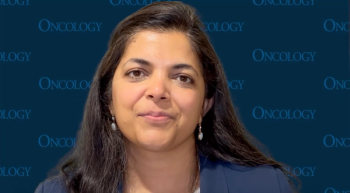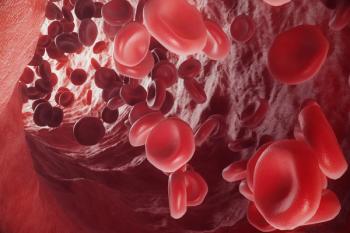
- ONCOLOGY Vol 13 No 3
- Volume 13
- Issue 3
Autologous Bone Marrow Transplantation for Patients With Advanced Hodgkin’s Disease: Long-Term Follow-Up and Late Events
We have previously shown that disease status at the time of autologous bone marrow transplant (BMT) and relapse in a prior radiation field are the most important predictors of outcome for patients with relapsed or primary refractory Hodgkin’s disease (J Clin Oncol 11:704,1993). We have extended this analysis to include 194 patients treated at our center, with a median follow-up of 5 years (range, 1 month to 10 years). All patients were treated with salvage chemotherapy (usually DHAP [dexamethasone, ara-C, and Platinol] or mini-BEAM [BCNU, etoposide, ara-C, and melphalan]) to maximum response, and received the same high-dose chemotherapy regimen, consisting of etoposide (60 mg/kg) and melphalan (160 mg/m²).
We have previously shown that disease status at the time of autologous bone marrow transplant (BMT) and relapse in a prior radiation field are the most important predictors of outcome for patients with relapsed or primary refractory Hodgkins disease (J Clin Oncol 11:704,1993). We have extended this analysis to include 194 patients treated at our center, with a median follow-up of 5 years (range, 1 month to 10 years). All patients were treated with salvage chemotherapy (usually DHAP [dexamethasone, ara-C, and Platinol] or mini-BEAM [BCNU, etoposide, ara-C, and melphalan]) to maximum response, and received the same high-dose chemotherapy regimen, consisting of etoposide (60 mg/kg) and melphalan (160 mg/m²).
Patient characteristics were as follows: median age, 31 years (range, 16-61 years); male, 62%; histology: nodular sclerosis, 78%, mixed cellularity, 15%, lymphocyte predominant, 4%; early stage (I or II) at initial presentation: 42%; B symptoms at presentation: 49%; extranodal involvement initially: none, 65%, one extranodal site, 24%, ³ 2 extranodal sites, 11%; relapse in previously irradiated field, 31%. Clinical complete remission (CR) was achieved prior to transplantation in 77 patients (40%).
Overall survival rates are 48% at 5 years and 30% at 10 years. When analyzed by remission status at transplant, median survival for patients transplanted in CR following salvage therapy was 7.9 years, compared to 2.5 years for patients transplanted in partial remission (PR; P < .0001). Overall survival rates for patients transplanted in CR are 83% at 5 years and 48% at 10 years, while for those transplanted in PR, survival rates at 5 and 10 years are 28% and 20%, respectively. Event-free survival (EFS) rates for all 194 patients at 5 and 10 years are 40% and 28%, respectively, with a median EFS of 2.2 ± 0.6 years. Actuarial EFS rates for patients transplanted in CR are 68% at 5 years and 42% at 10 years. For patients transplanted in PR, actuarial EFS rates are 24% at 5 years and 20% at 10 years. Median EFS for patients transplanted in CR has not been reached, and is 0.9 year for patients transplanted in PR (P < .0001). Ten-year EFS rates are similar for patients who relapsed in a prior radiation field compared to those who did not (30% vs 40%; P = .116 [log-rank test]).
There have been 8 late deaths (> 5 years posttransplant): 2 from complications of orthotopic liver transplantation, 3 from Hodgkins disease (1 after allogeneic BMT for relapsed disease), 1from secondary acute myelogenous leukemia (AML), 1 from squamous cell lung cancer, and 1from unknown cause. Late death accounted for 5 of the 15 deaths observed in the 77 patients transplanted in CR. There have been 4 cases of treatment-related MDS and 4 cases of treatment-related AML in the entire cohort.
CONCLUSION: Long-term remission is achievable in 28% of patients with relapsed or refractory Hodgkins disease, and disease status at the time of autologous BMT remains the most important predictor of outcome. Late, non-Hodgkins diseaserelated events contribute substantially to overall mortality of patients transplanted in CR.
Articles in this issue
almost 27 years ago
WHO Declares Lymphatic Mapping to Be the Standard of Care for Melanomaalmost 27 years ago
Navelbine Increased Elderly Lung Cancer Patients’ Survivalalmost 27 years ago
Consensus Statement on Prevention and Early Diagnosis of Lung CancerNewsletter
Stay up to date on recent advances in the multidisciplinary approach to cancer.

















































































